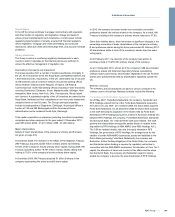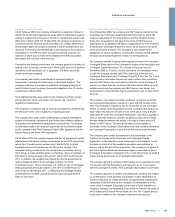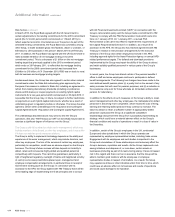RBS 2010 Annual Report Download - page 407
Download and view the complete annual report
Please find page 407 of the 2010 RBS annual report below. You can navigate through the pages in the report by either clicking on the pages listed below, or by using the keyword search tool below to find specific information within the annual report.
Risk factors
Set out below are certain risk factors which could adversely affect the
Group's future results and cause them to be materially different from
expected results. The Group's results could also be affected by
competition and other factors. The factors discussed in this report should
not be regarded as a complete and comprehensive statement of all
potential risks and uncertainties.
The company and its UK bank subsidiaries may face the risk of full
nationalisation or other resolution procedures under the Banking Act
2009.
Under the Banking Act 2009 (the “Banking Act”), substantial powers have
been granted to HM Treasury, the Bank of England and the FSA
(together, the “Authorities”) as part of a special resolution regime (the
“SRR”). These powers enable the Authorities to deal with UK banks,
building societies and other institutions with permission to accept
deposits pursuant to Part IV of the Financial Services and Markets Act
2000 (“FSMA”) (each, a “relevant entity”) where the conditions set out in
the next paragraph headed “The SRR may be triggered prior to the
insolvency of the company or its UK bank subsidiaries” are met. The SRR
consists of three stabilisation options and two insolvency and
administration procedures applicable to UK banks which may be
commenced by the Authorities. The stabilisation options provide for: (i)
transfer of all or part of the business of the relevant entity to a private
sector purchaser; (ii) transfer of all or part of the business of the relevant
entity to a “bridge bank” established by the Bank of England; and (iii)
temporary public ownership (nationalisation) of the relevant entity or its
UK-incorporated holding company. In each case, the Authorities have
been granted wide powers under the Banking Act including powers to
modify contractual arrangements in certain circumstances and powers for
HM Treasury to disapply or modify laws (with possible retrospective effect)
to enable the powers under the Banking Act to be used effectively. The
following paragraphs of this risk factor headed “The company and its UK
bank subsidiaries may face the risk of full nationalisation or other
resolution procedures under the Banking Act 2009” set out some of the
possible consequences of the exercise of those powers under the SRR.
The SRR may be triggered prior to the insolvency of the company or its
UK bank subsidiaries.
The purpose of the stabilisation options is to address the situation where
all or part of the business of a relevant entity has encountered, or is likely
to encounter, financial difficulties. Accordingly, the stabilisation options
may only be exercised if (a) the FSA is satisfied that a relevant entity
such as the company’s UK banking subsidiaries, including the Royal
Bank and NatWest, is failing, or is likely to fail, to satisfy the threshold
conditions within the meaning of section 41(1) of the FSMA (which are
the conditions that a relevant entity must satisfy in order to retain its
authorisation to perform regulated activities), (b) following consultation
with the other Authorities, the FSA determines that it is not reasonably
likely that (ignoring the stabilisation options) action will be taken that will
enable the relevant entity to satisfy those threshold conditions, and (c)
the Authorities consider the exercise of the stabilisation options to be
necessary, having regard to certain public interest considerations (such
as the stability of the UK financial systems, public confidence in the UK
banking systems and the protection of depositors). It is therefore possible
that one of the stabilisation options could be exercised prior to the point
at which any insolvency proceedings with respect to the relevant entity
(such as the Royal Bank or NatWest) or the company could be initiated.
The stabilisation options may be exercised by means of powers to
transfer property, rights or liabilities of a relevant entity and shares and
other securities issued by a relevant entity. HM Treasury may also take
the parent company of a relevant entity (such as the company) into
temporary public ownership provided that certain conditions are met.
Temporary public ownership is effected by way of a share transfer order
and can be actioned irrespective of the financial condition of the parent
company.
Various actions may be taken in relation to any securities issued by the
company without the consent of the holders thereof.
If HM Treasury decides to take the company into temporary public
ownership, it may take various actions in relation to any securities issued
by the company (the “Securities”) without the consent of holders of the
Securities, including (among other things):
(i) transferring the Securities free from any contractual, legislative or
other restrictions on transfer;
(ii) transferring the Securities free from any trust, liability or other
encumbrance;
(iii) extinguishing any rights to acquire Securities;
(iv) delisting the Securities;
(v) converting the Securities into another form or class (the scope of
which power is unclear, although may include, for example,
conversion of the Securities into equity securities);
(vi) disapplying any termination or acceleration rights or events of
default under the terms of the Securities which would be
triggered by the transfer or certain related events; or
(vii) where property is held on trust, removing or altering the terms of
such trust.
Where HM Treasury has made a share transfer order in respect of
securities issued by the holding company of a relevant entity, HM
Treasury may make an order providing for the property, rights or liabilities
of the holding company or of any relevant entity in the holding company
group to be transferred and where such property is held on trust,
removing or altering the terms of such trust.
The taking of any such actions may adversely affect the rights of holders
of the Securities, the price or value of their investment in the Securities
and/or the ability of the company to satisfy its obligations under the
Securities and/or contracts related to the Securities. Where the transfer
powers are effected, HM Treasury is required to make certain
compensation or resolution fund orders and holders of Securities may
have a claim for compensation under one of the compensation schemes
contemplated by the Banking Act if any action is taken in respect of the
Securities (and if the relevant order provides for the amount of
compensation payable to be determined by an independent valuer, then
for the purposes of determining an amount of compensation, the
independent valuer must disregard actual or potential financial assistance
provided by the Bank of England or HM Treasury). However, there can
be no assurance that compensation would be assessed to be payable or
that holders of the Securities would recover any compensation promptly
and/or equal to any loss actually incurred.
405RBS Group 2010
Additional information
























